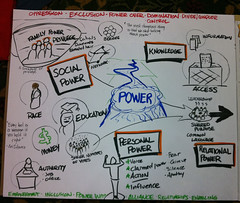Harvesting and typology
Some observations from recently harvesting for a group. The harvest artifact above is a sketch I did on a flipchart in the middle of a group last week who were debriefing conversations they were having about power. In the course of a 40 minute conversation, the group raised a number of types of power they perceived, based on stories they were telling and insights that were coming up.
I was reflecting afterwards with my colleague Ginny Belden-Charles on types of typologies. There are two kinds of categorization we were exploring and it is important not to confuse them, but to use them usefully. One is the typical piece of typology used as a meaning making scheme or categorization. In Cynefin terms this is the categorization scheme for simple decision making. In nominal group technique it is the categories. It could alos be the taxonomic ranking system in biology where an agreed upon set of categories is very important. In this case I think the categorization scheme matters as much as the content. For example, if we are solving a mechanical problem, we need to know which causes arise from materials, from human intervention, from fluids and so on. The categorization scheme matters.
The harvest above is an example of a categorization scheme that is a mnemonic, and is purely subjective. It is my own way of perceiving and remembering the conversation, and in that respect it can evoke the quality of the conversation as well as the points of content that were touched upon, but the meaning making scheme is not necessarily important. It is not always important that we check out the categorization scheme with the group (although it might be). It is useful to have the group add to a graphic like this.
Both of these schemes are important, and it is important to be conscious of how a harvester is using them.



thanks for this Chris!! the scheme matters as much as the content… indeed!
i am now heading towards Colombia with my KaosPilot team and amongst other projects we’ll “explore the leading edge of ingenuity in Bogotá” – and here the categorization scheme becomes very interesting and tricky as it is somehow the nature of leading edges and ingenuity to challenge existing categories and typologies, isn’t it? so as a project leader on this one i am holding the intention in the beginning to crowd-source both data (content) as well as metadata (categories) from regular 1&1 harvesting interviews and listen into what direction or focus is emerging. however, this is VERY challenging for some people who want to know right away what they ‘should’ look for… do you have an advice from your experience how to empower the natural explorer in people?
i would love to learn from someone who was involved in the development of the …
isn’t it nowadays that generating categories almost reaches the speed of generating content? as recombination of data is the ‘new’ creativity? so tools and pathways of empowering your inner curator in designing the narrative of this data/metadata dance will be THE thing i’d predict.
conceptual frameworks that are meant to transcend it’s creators scope…
ehm, the link-URL didn’t work, it’s “[…] development of the Ressource Description Framework http://en.wikipedia.org/wiki/Resource_Description_Framework” before the text gets blue in my comment 🙂